|
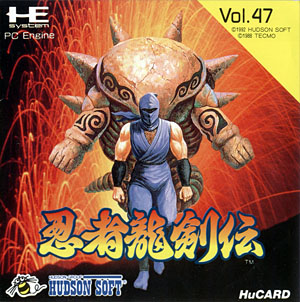
|

|
|
忍者龍剣伝
©1992 Hudson Soft
©1922 Tecmo
Vol.47
Release : 1992-01-24 (¥6500)
HuCard (4 Mbits) HC92052
Action / Platform game
|
Ninja Ryūkenden is a side scrolling action game by Hudson Soft
and based on the arcade game of the same name released by Tecmo in
1988 (it is rather a port of the Famicom game, see the info section). The
player controls Ryu Hayabusa, a fearless ninja on a quest of revenge. His
father was killed by a mysterious ninja during a fierce duel. After reading a
note left by his father, Ryu travels to the United States to meet
Dr. Walter Smith, one of his father's friend. But he soon gets head to
head with a young girl who hands him a weird looking statue before disappearing.
The complex plot of the game unfolds over no less than six acts (with a total of
nearly twenty stages) and Ryu will finally find out what happened to his
father and who hides behind his disappearance. Ryu Hayabusa is equipped
with a sword which he can use at lightning-speed to slash his enemies to bits.
He also has the incredible ability to wall-jump and to climb vertical surfaces.
Finally, Ryu can use his spiritual energy to augment his powers and trigger
powerful special attacks such as mystic shurikens or the ability to shoot
flames. Various energy forms scattered around some of the levels reward
Ryu with spiritual energy. They are often in the shape of burning flames
but they also come in various forms such as insects or small animals.
|
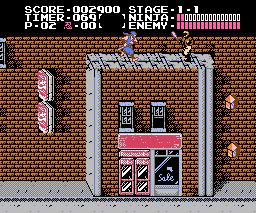 The PC Engine version tested here is a port of Ninja Ryūkenden
originally released for the Famicom in 1988 (picture on the right). The conversion features
enhanced graphics, a (surprisingly choppy) parallax scrolling and a totally
different soundtrack. Enemy placements are also slightly different and
although the levels layout is fairly similar, most of the backgrounds were redesigned.
Curiously, some of the character names were also changed - for instance,
Ken Hayabusa was surprisingly renamed Joe Hayabusa.
Interestingly, an option in the game's menu allows the player to change
the cut scenes from Japanese (default) to English and
Chinese (see the Secrets section). As a side note, a
Super Famicom version of the game was released in 1995 (which
included all three Famicom games) as part of a Ninja Ryūkenden Trilogy
called Ninja Ryūkenden Tomoe - however, it featured the same graphics than
the Famicom version with an extended color palette.
The PC Engine version tested here is a port of Ninja Ryūkenden
originally released for the Famicom in 1988 (picture on the right). The conversion features
enhanced graphics, a (surprisingly choppy) parallax scrolling and a totally
different soundtrack. Enemy placements are also slightly different and
although the levels layout is fairly similar, most of the backgrounds were redesigned.
Curiously, some of the character names were also changed - for instance,
Ken Hayabusa was surprisingly renamed Joe Hayabusa.
Interestingly, an option in the game's menu allows the player to change
the cut scenes from Japanese (default) to English and
Chinese (see the Secrets section). As a side note, a
Super Famicom version of the game was released in 1995 (which
included all three Famicom games) as part of a Ninja Ryūkenden Trilogy
called Ninja Ryūkenden Tomoe - however, it featured the same graphics than
the Famicom version with an extended color palette.
|
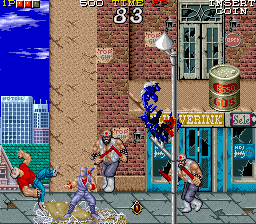 The original arcade game Ninja Ryūkenden (aka Ninja Gaiden
in the US and Shadow Warriors in Europe) was released by Tecmo
in 1988 (picture on the left). However, the original game shares little in common with home console
conversions and was more a two-player beat'em up featuring large sprites on
screen. As mentioned earlier, the PC Engine version tested here is in fact a conversion of
Ninja Ryūkenden originally released in 1989 for the Famicom.
Two sequels followed, Ninja Ryūkenden II: Ankoku no Jashinken (Famicom, 1990)
and Ninja Ryuukenden III: Yomi no Hakobune (Famicom, 1991). Ninja Gaiden
was also released for various systems and sequels are still produced to this day.
Here is a non exhaustive list :
Ninja Gaiden (Sega Master System, 1988),
Ninja Gaiden (Sega Game Gear, 1991),
Ninja Gaiden (Atari Lynx, 1991),
Ninja Gaiden III (Atari Lynx, 1991),
Ninja Ryūkenden GB Matenrou Kessen (Game Boy, 1991),
Ninja Ryūkenden Tomoe (Super Famicom, 1995),
Ninja Gaiden Episodes (Mobile Phone, 2004),
Ninja Gaiden (Xbox, 2004),
Ninja Gaiden Black (Xbox, 2005),
Ninja Gaiden Sigma (Playstation 3, 2007),
Ninja Gaiden: Dragon Sword (DS, 2008),
Ninja Gaiden II (Xbox360, 2008),
Ninja Gaiden Sigma II (Playstation 3, 2009).
The original arcade game Ninja Ryūkenden (aka Ninja Gaiden
in the US and Shadow Warriors in Europe) was released by Tecmo
in 1988 (picture on the left). However, the original game shares little in common with home console
conversions and was more a two-player beat'em up featuring large sprites on
screen. As mentioned earlier, the PC Engine version tested here is in fact a conversion of
Ninja Ryūkenden originally released in 1989 for the Famicom.
Two sequels followed, Ninja Ryūkenden II: Ankoku no Jashinken (Famicom, 1990)
and Ninja Ryuukenden III: Yomi no Hakobune (Famicom, 1991). Ninja Gaiden
was also released for various systems and sequels are still produced to this day.
Here is a non exhaustive list :
Ninja Gaiden (Sega Master System, 1988),
Ninja Gaiden (Sega Game Gear, 1991),
Ninja Gaiden (Atari Lynx, 1991),
Ninja Gaiden III (Atari Lynx, 1991),
Ninja Ryūkenden GB Matenrou Kessen (Game Boy, 1991),
Ninja Ryūkenden Tomoe (Super Famicom, 1995),
Ninja Gaiden Episodes (Mobile Phone, 2004),
Ninja Gaiden (Xbox, 2004),
Ninja Gaiden Black (Xbox, 2005),
Ninja Gaiden Sigma (Playstation 3, 2007),
Ninja Gaiden: Dragon Sword (DS, 2008),
Ninja Gaiden II (Xbox360, 2008),
Ninja Gaiden Sigma II (Playstation 3, 2009).
|
Game Staff (Copied from the end credits) :
|
Ninja Ryūkenden
Staff
Producer
Eiji Aiyama
Director
Yoshiyuki Kawaguchi
Program Design
Ricky Sun
Sammy Hau
|
|
Graphic Design
Matthew Yau
David Tang
Carlton Wong
Siu Wai
Message
Geshu Cho
K.L.Sutherland
Loretta Hieh
Wendy Liu
|
|
Special Thanks
Masanori Wake
Koji Matsuura
Toshiaki Takimoto
Yasuhiro Ichizawa
AUDIO VISUAL
COPYRIGHT MCMLXXXVIII
TECMO LT
THE END
HUDSON SOFT CO.,LTD.
1992
|
|
|
O
M
A
K
E
|
|
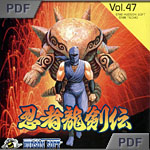
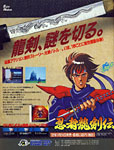
|
|
|
Click on picture to enlarge |
S
E
C
R
E
T
S
|
|
Change cutscene language:
Go to the title screen, hold I and II, then press
Select to cycle through the available languages (the
title should change to the desired language). Three are
available - Japanese (Default), English
and Chinese.

|
|
|
|
LK

|
|
Add your Pov here !
|
P
O
V
s
|
|
Ninja Ryūkenden has an extremely well laid out story with long
animated cut scenes and rich, deep characters. The storyline is what makes
Ninja Ryūkenden really stand out of the crowd. Levels are relatively
large and varied with incredibly detailed environments and locations. However,
sprites are on the tiny side of small and the control system can be tricky to
master. It is both the bravest and the most flawed innovation I'm afraid - the
ability to stick on walls is great but can be a real pain at times and often
results in countless cheap deaths. Enemies also respawn at an irritating rate - for
instance, the same eagles will reappear from the same spawn points and this is a
major flaw which quickly becomes really frustrating. Then Ninja Ryūkenden
is hard, nasty hard, and worst of all, unfair. Some boss encounters are just games
of luck - in some cases, you just need to get there with a full bar of energy and
slap them hard while taking full-on damages to defeat them. All in all, Ninja
Ryūkenden is a hard and frustrating action platformer but, difficulty aside, its
enduring popularity is due, no doubt, to moments of pure brilliance and creativity
sadly sprinkled with irritating gameplay paradoxes.
|
|
|
|